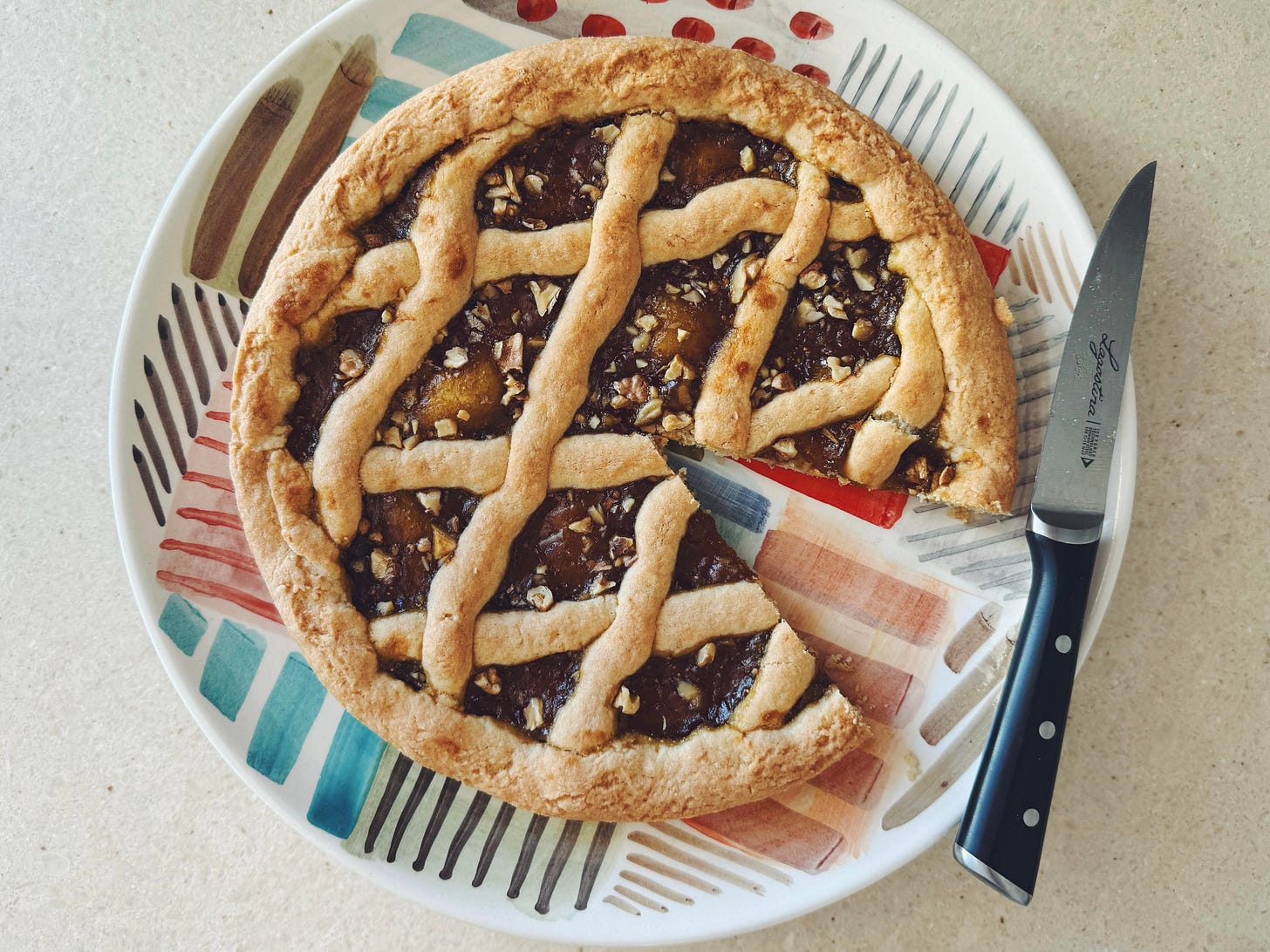
Welcome to Buona Domenica, a weekly newsletter of Italian home cooking and baking. I’m a journalist, cooking teacher, occasional tour guide, and author of eight cookbooks on Italian cuisine.
This week’s newsletter features a recipe for paid subscribers: Crostata di Fichi e Noci—fig jam and walnut crostata in a whole-wheat crust.
Click here to browse through the newsletter archive. If you’re looking for a particular recipe, you’ll find all Buona Domenica recipes—160 and counting—indexed here, ready to download and print—a function for paid subscribers. Although many recipes are initially free when I publish them here, they do go behind a paywall after a few weeks.
If you are able to do so, please consider supporting my work by becoming a paid subscriber. Grazie.
On to the newsletter…
Greetings from la strada, Readers.
As I write this, I am finishing up a swing through southern Italy that has taken me to Naples and Campania, Basilicata, and—by the time you read this—Lecce and other parts of Puglia. I will write more about some of these places at some point, but at the moment my brain feels a bit like a fritto misto, which is to say battered and fried. Many thousands of steps in 100° F (38° C) heat will do that.
On the other hand, I think back to exactly this time last year, when I had just been operated on after breaking my ankle, was sporting first a heavy cast, then a boot, and was beginning four weeks of strict bed rest with an elevated leg. Nightmare—except for the part where my husband took great care of me and cooked for me every day. Now, I’ve just come from my second solo road trip of the summer, including two days in Matera, with its stone-paved streets and treacherously steep steps, and though this terrain most definitely tried my ankle, I’m pleased with how well I was able to get around. No question that my ankle is feeling it, though, and I am looking forward to a few days back home in Penne.*
* also a hilly town, and one with poorly maintained streets, but at least I will not be rushing around…
This week, I want to share a recipe for a fig and walnut crostata that I had in Umbria and that I reproduced at home last week. Since I was leaving town again the day after I made it, I gave a portion to my next-door neighbor in Penne, who later texted to tell me it was the best crostata she had ever had. Hyperbole? Maybe. Make it and decide for yourself. I myself would have a hard time choosing a favorite crostata; there are too many. Such as:
Crostata alla Stracciatella
Crostata al Limone
Strawberries and Cream Crostata
My Favorite Apple Croatata
While dried figs stuffed with freshly shelled walnut pieces is one of my favorite winter snacks, I don’t usually associate this duo with summer. But during my stay in Umbria a couple of weeks ago, I noticed that several bakeries were featuring figs—fig preserves, actually—and walnuts together in their pastries, most often as a filling for cookies or in rustic tarts like this one. A whole-wheat fig and walnut crostata, made with locally milled flour, was on the dessert menu at Scottadito, the restaurant in Bevagna where I ate dinner two nights in a row (see last week’s newsletter). Both times, I was too full to order dessert, so I ended up buying a slice to take back to my hotel to enjoy for breakfast the next day.
What set this crostata apart from other jam crostatas was the crumbly whole-wheat crust, which made a fine rustic bed for the fruit and nut filling. I know some people might not find three shades of brown appealing in a dessert, but I happen to like a plain-looking dolce that delivers on flavor. I came up with my own version as soon as I got back home to Penne (and before hitting the road once more). I used my basic pasta frolla recipe as a template, but changed it to yield a rustic, crumbly, partial whole-wheat crust.
In the U.S., I make classic pasta frolla—the sweet, egg- and butter-enriched dough that encases a crostata filling—in in a food processor, using extra-cold butter and pulsing until the dough comes together. But since I don’t have that appliance in my kitchen in Penne, I mixed the dough the old-fashioned way, rubbing softened (but still cool) butter into the dry ingredients with my fingertips, adding the eggs, and then and mixing it all together and patting it into a disk of dough with my hands. This unplugged method was easy and enjoyable—we sometimes forget how nice it is to get our hands in dough—and I didn’t have to wash a food processor.
Easy to make, though not so easy to roll out. Whole wheat inhibits gluten development, so a dough with whole-wheat flour in it can break apart as you roll it. Be sure to let it rest and chill thoroughly in the refrigerator after you’ve mixed it, even overnight if you have the time. Then, let it soften a bit at room temperature before rolling it out, making sure it is still on the cool side. If it’s too cold, it will crack when you try rolling it out with the rolling pin; if it’s not cold enough, it will come apart when you try to transfer it to the tart pan. You see what I mean. Fussy.
Flour the dough, your work surface, and your rolling pin as needed to prevent the dough from sticking as you roll. Be persistent but patient, as it is well worth mastering this rustic and delicious dough. Pat it together if it tears, and if it keeps up the bad behavior, just gather up the pieces, ball them back up into a disk, and chill again before rolling out once more. If it still has a tendency to break apart, just press the pieces into the tart pan to line it and don’t worry too much about appearance. Rustic is what we are aiming for anyway. For a less capricious dough, use my recipe for classic pasta frolla.
RECIPE: Crostata di Fichi e Noci
This homey crostata makes a nice breakfast treat, especially with coffee. But it is also a fine dessert. To firmly bring this crostata into the realm of summer, serve it slightly warm, topped with a big scoop of vanilla ice cream.
Keep reading with a 7-day free trial
Subscribe to Buona Domenica to keep reading this post and get 7 days of free access to the full post archives.





